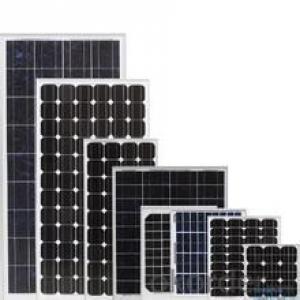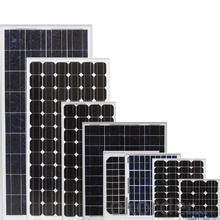Concentrator Polysilicon Broken Solar Cells
- Loading Port:
- China Main Port
- Payment Terms:
- TT OR LC
- Min Order Qty:
- -
- Supply Capability:
- -
OKorder Service Pledge
Quality Product, Order Online Tracking, Timely Delivery
OKorder Financial Service
Credit Rating, Credit Services, Credit Purchasing
You Might Also Like
Quick Details
| Model Number: | |||||
| Material: | Size: | Max. Power: | |||
| Working Voltage: | Working Current: | Conversion Rate: | |||
| Standardtest Conditions: | Insulation Voltage: | Border Ground Resistance: | |||
| Operation Temp: | Working Life: |
Packaging & Delivery
| Packaging Detail: | Wooden Box |
| Delivery Detail: | according the quantity |
Specifications
1Withstand high wind pressure and snow load
2Color uniformity
3Low breakage rate
4Mono and Poly both are OK.

| product Name | Solar Cell Panel | Standard Test Conditions | Irradiance=1000W/m2,BTemp=25°C |
| Power | 6KW | Insulation Voltage | ≥600V |
| Working voltage | 60V | Border Ground Resistance | ≤10hm |
| WorkingCurrent | 110A | Wind Pressure | 2400Pa |
| Open Circuit Voltage | Over-voltage Protection | Fill Factor | 0.73 |
| Short-circuit Current | Over-current Protection | TK Isc | 0.4mA/°C |
| Conversion Rate | 15%-21% | TK Isc | 60mV/°C |
| Size(mm) | Optional | OperatinTemperature | Subzero40°C~90°C |
| Weight | Optional | Service Life | 20-25 years |
| Materiale | Single Crystal Silicon /Polysilicon /Amorphous Silicon /Multiple Compound Film Nanocrystalline /Nanocrystalline | ||
| Connection | Series Connection Parallel Connection | ||
| Bracket | Yes | No | |
| Encapsulation Mode | Epoxy Potting / PET Laminated / Glass Laminated | ||
| Solar Cell Type | Glass | EVA | TPT | Border |
| polysilicon | solar low iron glass | additives:anti-ultraviole tagents | ageing resistance | aluminium alloys |
| single crystal silicon | thickness:3.2mm | antioxidants | corrosion resistance | high strength |
| amorphous silicon | luminousness:91% | curing agent | imporosity | high mechanical impact |
| multiple compound film | highly resistant to UV radiation | thickness: 0.78mm | ||
| nanocrystalline | high light transmittance anti-aging ability |
- Q: Can solar cells be used in mobile devices?
- Yes, solar cells can be used in mobile devices. In fact, many manufacturers are now incorporating solar panels into smartphones, tablets, and other portable gadgets to harness solar energy and provide an alternative source of power.
- Q: What is the size and weight of a typical solar cell?
- The size and weight of a typical solar cell can vary depending on its application and design. However, a common size for residential solar panels is around 65 inches by 39 inches, with a weight of approximately 40 pounds.
- Q: How does the solar panel produce it yourself?
- Titanium Dioxide Film The titanium dioxide powder was first put into a mortar and ground with a binder. The film was then slowly dried on a conductive glass with a glass rod. The titanium dioxide film was sintered in an alcohol lamp for 10 to 15 minutes and then cooled The
- Q: How are solar cells connected in a photovoltaic system?
- Solar cells are typically connected in a photovoltaic system in series or parallel configurations to create a larger, more efficient energy-generating unit.
- Q: What is the typical warranty for solar cells?
- The typical warranty for solar cells ranges from 10 to 25 years, depending on the manufacturer and type of solar cell.
- Q: What is the role of bypass diodes in solar cell arrays?
- The role of bypass diodes in solar cell arrays is to minimize the impact of shading or partial shading on the overall performance of the array. They provide an alternative path for the current to flow, allowing the unaffected cells to continue producing electricity while the shaded cells are bypassed. This prevents the shaded cells from acting as a resistor and reduces the risk of hotspots or damage to the cells.
- Q: How do solar cells perform in areas with extreme temperature fluctuations?
- Solar cells typically perform well in areas with extreme temperature fluctuations. However, excessive heat can slightly reduce their efficiency, while extreme cold can temporarily decrease their power output. Nonetheless, solar cells are designed to withstand a wide range of temperatures, and advancements in technology have improved their performance and durability in extreme weather conditions.
- Q: Can solar cells be used to power cars?
- Yes, solar cells can be used to power cars. Solar-powered cars use photovoltaic cells to convert sunlight into electricity, which is then used to power the vehicle's electric motor. However, due to limitations in efficiency and energy storage, solar-powered cars are currently not as practical as traditional gasoline or electric cars for everyday use.
- Q: Can solar cells be used in desalination plants?
- Yes, solar cells can be used in desalination plants. Solar energy can be harnessed by solar cells to power the desalination process, making it a sustainable and environmentally friendly approach. The solar cells can generate electricity to run the desalination equipment, such as reverse osmosis systems, efficiently converting saltwater into freshwater.
- Q: Can solar cells be used in disaster recovery efforts?
- Yes, solar cells can be used in disaster recovery efforts. Solar cells can provide a reliable and sustainable source of electricity in areas affected by disasters, where traditional power grids may be damaged or inaccessible. They can be used to power emergency shelters, hospitals, communication systems, and other critical infrastructure, ensuring that essential services and relief efforts are not disrupted. Additionally, solar cells can be easily deployed and are not dependent on fuel supply, making them an ideal solution for disaster recovery efforts.
Send your message to us
Concentrator Polysilicon Broken Solar Cells
- Loading Port:
- China Main Port
- Payment Terms:
- TT OR LC
- Min Order Qty:
- -
- Supply Capability:
- -
OKorder Service Pledge
Quality Product, Order Online Tracking, Timely Delivery
OKorder Financial Service
Credit Rating, Credit Services, Credit Purchasing
Similar products
Hot products
Hot Searches
Related keywords



















